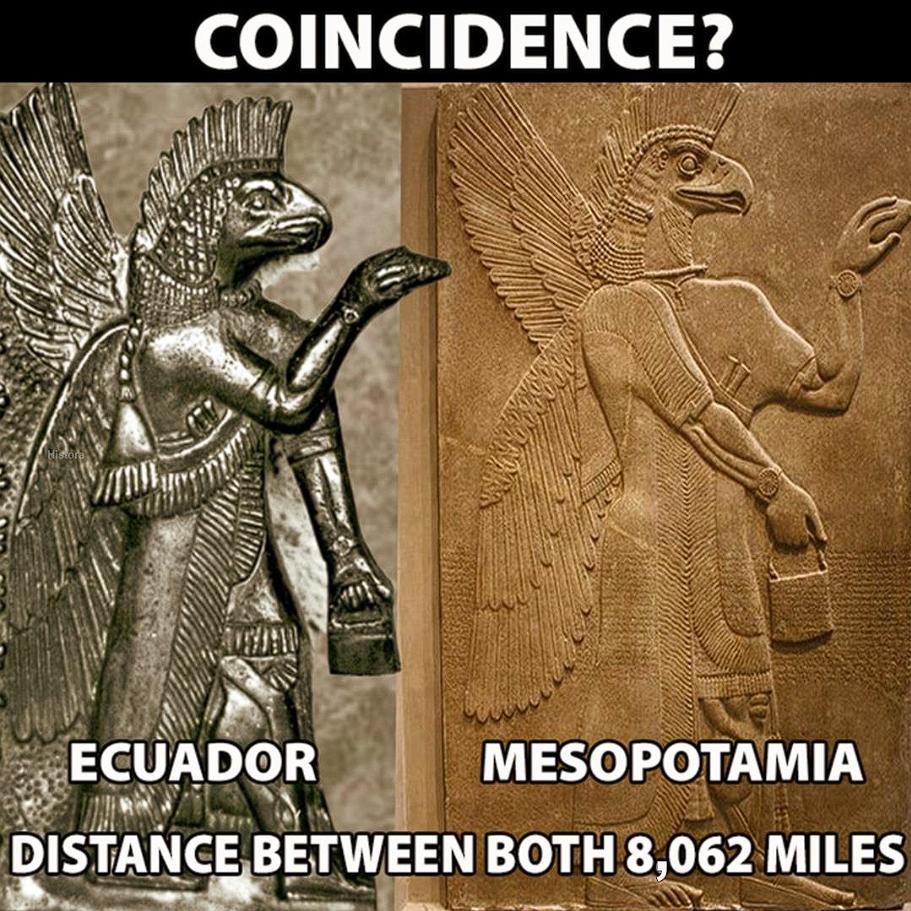It’s an undeniably arresting moment, prompting profound pause and reflection, when confronted with an artifact as perplexing as this: a statue bearing an uncanny resemblance to Ninurta, the formidable Sumerian god of war and agriculture, a deity well-known from numerous Mesopotamian archaeological sites—yet discovered in the distant land of Ecuador. Among the intriguing collection of artifacts once held by the enigmatic Father Carlo Crespi in South America resides a sculpture that exhibits a truly striking similarity to established depictions of Ninurta from the ancient Middle East.
Unsettling Similarities: Bridging Oceans and Civilizations
The resemblance between the Ecuadorian sculpture and the traditional representations of Ninurta is far more than superficial. The very stance of the figure, the distinct weaponry it wields, and even the intricate iconographic details seem to directly mirror artistic conventions prevalent in ancient Mesopotamian art. This profound similarity presents a significant historical puzzle, as these two ancient cultures were geographically separated by vast oceans and sprawling continents, with no conventional historical narrative to adequately explain such a direct and specific artistic connection.
A Mirror Image: Stance, Weaponry, and Iconography
The Ecuadorian sculpture exhibits a posture and bearing remarkably consistent with how Ninurta is typically depicted in Mesopotamian art. Furthermore, the weaponry held by the figure bears a striking resemblance to the specific types of weapons associated with the Sumerian deity. Even more intriguingly, subtle iconographic elements and symbolic details present on the Ecuadorian sculpture appear to echo those found in ancient Middle Eastern representations of Ninurta, suggesting a connection that transcends mere chance.
The Puzzle of Distance: Separated by Continents and Oceans
The sheer geographical distance separating ancient Mesopotamia and pre-Columbian Ecuador presents a significant hurdle to conventional explanations for this artistic similarity. The vast expanse of the Atlantic and Pacific Oceans, coupled with the continental landmasses of North and South America, would have posed formidable barriers to direct cultural exchange during the time period in question, according to established historical timelines and technological capabilities.
Challenging Conventional Historical Narratives
The existence of such a strikingly similar artifact in South America challenges the widely accepted historical narrative of limited or non-existent contact between the Old World and the Americas in antiquity. The specificity of the resemblance to Ninurta, a relatively distinct deity within the Mesopotamian pantheon, makes the possibility of mere coincidence or independently developed shared archetypes seem increasingly improbable.
Rethinking the Ancient World: Coincidence, Archetypes, or Ancient Contact?
The appearance of a seemingly Mesopotamian deity in South America compels us to consider a range of potential explanations, each with profound implications for our understanding of the ancient world. Could this be a remarkable coincidence, a fleeting convergence of independently developed artistic styles? Could it be the manifestation of shared human archetypes, universal symbolic expressions that arose in isolation? Or are we, perhaps, looking at tangible evidence of ancient contact between seemingly distant civilizations, long before such interactions were believed to have been technologically feasible?
The Long Shot of Coincidence: An Unlikely Convergence?
While coincidences do occur, the specific and detailed nature of the resemblance between the Ecuadorian sculpture and Mesopotamian depictions of Ninurta makes a purely coincidental explanation seem increasingly unlikely. The convergence of stance, weaponry, and specific iconographic details points towards a more direct connection than random chance would typically allow.
Shared Human Archetypes: Universal Symbolic Expressions?
The theory of shared human archetypes suggests that certain fundamental symbols and artistic expressions can arise independently in different cultures due to shared human experiences and psychological structures. While this could potentially explain some general similarities in ancient art, the highly specific resemblance to a particular deity like Ninurta makes this explanation less compelling in this instance.
The Intriguing Possibility of Ancient Contact: Rewriting History?
The most provocative explanation for the Ninurta-like figure in Ecuador is the possibility of ancient contact between distant civilizations, predating the conventionally accepted timelines of intercontinental travel. If substantiated, such evidence would necessitate a significant rewriting of our understanding of ancient global interactions and the technological capabilities of early societies.
A Call for Re-evaluation: A More Interconnected Ancient World
Discoveries such as the Ninurta-like statue from Ecuador serve as powerful catalysts, challenging us to critically re-examine the established narratives of the ancient world. They invite us to consider a broader, more interconnected story of human history, one that may have left a far more intricate web of clues scattered across the globe than we have ever previously imagined. These enigmatic artifacts beckon further investigation and open up exciting new avenues for understanding the complex tapestry of our shared human past.
Conclusion: Unraveling the Mysteries of Ancient Connection
The enigmatic appearance of a Ninurta-like figure in Ecuador presents a compelling archaeological puzzle that challenges our conventional understanding of the ancient world. Whether it is a remarkable coincidence, a manifestation of shared archetypes, or, most intriguingly, a potential piece of evidence for ancient intercontinental contact, the Mykonos Vase compels us to reconsider the interconnectedness of early civilizations. Discoveries like these serve as potent reminders that our knowledge of the past is constantly evolving, and that the world may hold far more intricate and surprising connections than we currently comprehend. Further research and analysis of such baffling artifacts promise to unlock new chapters in the story of human history, inviting us to explore the possibility of a more globally aware and interconnected ancient world than we ever thought possible.

CÁC TIN KHÁC
Mary Walton: The Forgotten Inventor Who Helped Clean Up America’s Cities
Tomb of Queen Nefertari in the Valley of the Queens, Egypt
Discover the Hypostyle Hall of the Temple of Hathor at Dendera
Venus de Losange: Unveiling the Mystery of a 20,000-Year-Old Paleolithic Icon